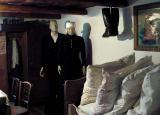2025. July 11. Friday
German Region House - Újbarok

|
Address: 2066, Újbarok Fő u. 33.
Opening hours: During the opening hours of the Cultural Centre or on prior notice. (Tue 17.00-21.00, Thu 17.00-20.00, Fri-Sat 16.00-20.00, Sun 15.00-20.00)
|
The village "Újbarok" was not populated directly with Germans from Gemany. Instead, German settlers arrived from Felsőgalla and Pilisvörösvár to obliterate forests in 1773, an action initiated by the Rosty family.
Only an insignificant quantity of land belonged to the village so agriculture did not play crucial part in the life of the village. Nevertheless, there still lived a few proprietors in Újbarok.
Handicraft, on the other hand, was significant. Most of the residents worked in Budapest. Young girls served rich families, Men worked at the Herz Salami factory, the Mint or at MÁV.
The county room was set up by the German Minority Self-government in 2003. The collection is located in two rooms.
Entering the house, the visitors find themselves in the furnished kitchen with jugs, jars, plates, scales etc. Various objects hung on the walls while the table is covered with a characteristic table cloth with old coins on top.
The visitors then enter the room under an arch. The room is furnished as a typical living room with objects like a paddle, spinning-wheel, prayer book etc in. The bed is placed in the corner with an eiderdown and four giant embroidered cushions. The small chest stands at the bed, the "khaszl" with old photos and two painted pictures. Chairs are placed in front of the bed and "khaszl" with embroidered covers on. Photos and a holy water case are to be found on the wall.
Only an insignificant quantity of land belonged to the village so agriculture did not play crucial part in the life of the village. Nevertheless, there still lived a few proprietors in Újbarok.
Handicraft, on the other hand, was significant. Most of the residents worked in Budapest. Young girls served rich families, Men worked at the Herz Salami factory, the Mint or at MÁV.
The county room was set up by the German Minority Self-government in 2003. The collection is located in two rooms.
Entering the house, the visitors find themselves in the furnished kitchen with jugs, jars, plates, scales etc. Various objects hung on the walls while the table is covered with a characteristic table cloth with old coins on top.
The visitors then enter the room under an arch. The room is furnished as a typical living room with objects like a paddle, spinning-wheel, prayer book etc in. The bed is placed in the corner with an eiderdown and four giant embroidered cushions. The small chest stands at the bed, the "khaszl" with old photos and two painted pictures. Chairs are placed in front of the bed and "khaszl" with embroidered covers on. Photos and a holy water case are to be found on the wall.
